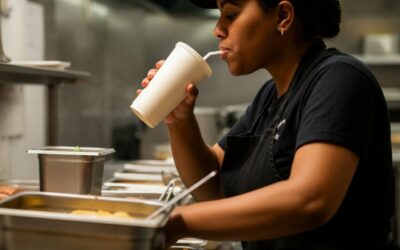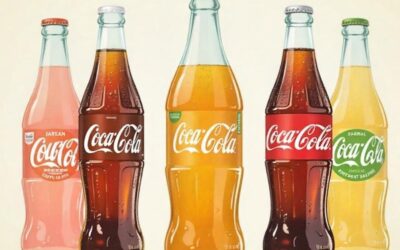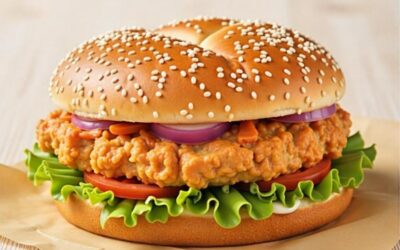Food service workers are often the unsung heroes of our daily routines, ensuring meals are prepared, packaged, and presented with care. But what about their own breaks and personal habits? One common question that arises in the food service industry is whether a food worker, during their break, can drink from an uncovered cup and, more importantly, where this is allowed. This seemingly small detail ties directly to food safety regulations and workplace hygiene, crucial aspects of the food service industry.
This blog will address the specific guidelines surrounding where food workers can properly drink from an uncovered cup, the reasoning behind these regulations, and practical takeaways for workers and employers alike.
Why Food Safety Compliance Matters

Food safety is not just about protecting customers—it’s also about maintaining a clean and compliant workplace for everyone involved. The food service industry must adhere to specific health codes established by regulatory agencies such as the FDA (Food and Drug Administration) in the United States. These codes aim to prevent contamination, keep food safe, and protect public health.
Drinking from an uncovered cup, although seemingly harmless, can expose food to potential contaminants, such as saliva or airborne particles. Maintaining proper drinking protocols isn’t just about rules—it’s about upholding the safety of our shared food supply chain.
Can a Food Worker Use an Uncovered Cup?
The short answer is yes—but only under specific circumstances and in the right location. Knowing when and where it’s permissible is critical to staying compliant with workplace safety standards.
According to the FDA Food Code Section 2-401.11, employees are prohibited from eating, drinking, or using tobacco in food preparation, storage, or service areas. However, workers can drink during their breaks in designated areas separate from areas where food or food contact surfaces are exposed.
This means a food worker may drink from an uncovered cup in a designated break area away from food-handling zones.
Why Designated Break Areas Are Essential

Designated break areas serve as safe zones for food workers to relax and maintain the integrity of food safety practices. These areas are typically designed to prevent cross-contamination risks. Here’s why they matter:
Reduced Risk of Food Contamination: By isolating drinking and eating activities from food prep or service areas, you minimize the possibility of bacteria or foreign particles entering food supplies.
Regulation Compliance: Adhering to this separation helps businesses comply with health inspection standards, avoiding violations that could result in fines or shutdowns.
Worker Well-being: A designated space ensures employees enjoy their breaks comfortably without worrying about breaking workplace policies.
For example, a small coffee shop might designate a corner of its stockroom with a table and chairs for food workers to relax away from the food prep counters. Alternatively, larger restaurants often designate staff break rooms for exactly this reason.
Practical Guidelines for Food Workers
If you’re a food worker wondering how to enjoy your drink during a break safely, here’s a quick guide:
Choose the Right Location
- Always step into a designated break area before drinking or eating.
- Avoid consuming anything (including drinks) in food prep, storage, or service spaces. This includes behind counters, in kitchens, or around food stations.
Use Covered Cups in Work Areas
- While uncovered cups are permitted in break areas, food and beverage containers with secure, resealable lids are the only acceptable options in food prep spaces.
- These containers protect drinks from contamination while preventing accidental spills into food or onto surfaces.
Practice Good Hygiene
- Wash your hands thoroughly before and after returning to work, especially after handling any food or drink item.
- Clean up any crumbs or spills immediately if consuming food or drink in approved spaces.
Understand Your Local Regulations
- While the FDA Food Code sets the groundwork for most health codes, specific regulations may vary depending on your state, city, or municipality.
- Confirm with your manager or review your local food safety guidelines to ensure proper compliance.
How Employers Can Help
Employers play a vital role in creating a food-safe environment while supporting their employees’ well-being. Here’s how they can strike that balance:
Clearly Define Designated Break Areas
Employers should establish and maintain clean, welcoming break areas that are separate from food preparation or storage zones. Providing signage can help clarify designated spaces.
Provide Resealable Drinking Containers
Employers can invest in spill-proof, resealable cups for employees during their shifts. This reinforces hygiene standards while accommodating workers’ needs.
Educate Staff on Food Safety Guidelines
Hosting regular training sessions about food safety and hygiene can reduce confusion and prevent violations. Cover common questions such as where workers can drink and why compliance is important.
Encourage Open Communication
Employees may have concerns or uncertainties about workplace policies. Employers should foster a culture where questions and feedback are welcome.
Examples of Real-Life Scenarios
To better illustrate the do’s and don’ts of drinking from an uncovered cup as a food worker, consider these scenarios:
Scenario 1:
A coffee shop barista places their uncovered iced latte on the counter next to where they are preparing milk foam for customer drinks.
Result: This breaks food safety guidelines because the drink is on a food-preparation surface and exposed to the customer-serving area.
Scenario 2:
A restaurant line cook takes an uncovered water bottle into a staff-only break room for a quick sip while off duty.
Result: This complies with food safety regulations because they are in a designated break area.
Scenario 3:
A fast-food cashier drinks a soda from a resealable bottle while standing behind the counter during a slow period.
Result: This complies with food safety guidelines, as long as the bottle is resealable and properly sealed while not in use.
Frequently Asked Questions
Q: Can employees drink from open containers while working in a food preparation area?
A: No, open containers are not allowed in food preparation areas as they pose a contamination risk. Drinks should be in resealable containers and consumed in designated areas away from food preparation.
Q: What containers are considered acceptable for beverages in staff areas?
A: Acceptable containers such as bottles with caps or cups with tight-fitting lids can be securely resealed. These help prevent spills and contamination.
Q: Are employees required to leave their drinks outside the workspace entirely?
A: Not necessarily. Staff are permitted to have beverages in approved containers, but they must store and consume them in areas designated as safe and appropriate, such as break rooms or away from food handling zones.
Q: What happens if an Employee accidentally brings an open container into a food prep area?
A: If this happens, the area and any potentially contaminated items should be sanitized immediately to maintain food safety standards. Proper training can help prevent such incidents.
Empowering Food Workers to Stay Compliant
Understanding the why and how of workplace regulations empowers food service workers to follow them confidently. Drinking from an uncovered cup may seem trivial, but respecting the boundaries of designated areas helps protect food safety, the business’s reputation, and customer trust.
Conclusion
Maintaining food safety standards requires diligence, awareness, and commitment from every Team member in the workplace. By fostering a culture of compliance and providing proper training, businesses can ensure that workers and customers are protected. Simple actions, like following designated area rules and sanitizing thoroughly, contribute significantly to the operation’s success. Together, these efforts uphold the integrity of the food service industry and create an environment where safety and quality thrive.
Food workers and employers can thrive in a safer and healthier environment by fostering a culture of care and compliance where everyone understands the rules and rationale.



















